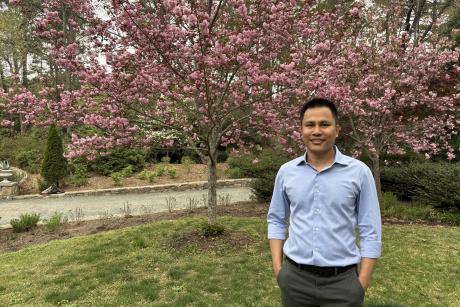
Dr. Dennis Clements and a group of Duke Students outside the hospital in Las Mercedes, Honduras.
Published October 24, 2011, last updated on March 5, 2013 under Education News
By the Duke Medical Alumni Association
Getting to the village of Las Mercedes is a rough ride, 5,000 feet up steep dirt roads in the mountains of Honduras. The people living here are lucky if they get three years of public education before going to work in the fields at age 10-14. They survive on less than $1 a day and live a long day’s walk over treacherous roads from hospital or medical care.
One aspect of that hard life changed in April, when Dennis Clements and a group of Duke medical and nursing students and faculty joined representatives from Heifer International and residents of Las Mercedes and 12 surrounding villages to celebrate the official opening of the first health clinic ever to serve the Intibuca region of Honduras. Beginning in June, the clinic will be staffed fulltime by the Honduran Ministry of Health.
Land for the clinic was donated by Ruhino Dominguez, the president of Las Mercedes, and Clements secured donations from Rotary International and the Congregation of Duke Chapel. The building was constructed by the Duke Chapter of Engineers without Borders, and it is the only building with running water and solar power for hundreds of miles around.
Clements, who is chief of Duke Children’s Primary Care and professor of pediatrics and global health, has been bringing groups of 15 medical and nursing students to Las Mercedes since 2000, when he was asked by the Duke University School of Nursing to develop a global health education course as part of a small grant.
He could appreciate the value of a global health experience. In 1972, as a self-described “Peacenik” and Vietnam War protester, he jumped at the chance to take a year off from the University of Rochester School of Medicine and Dentistry to do a National Institutes of Health fellowship in Uganda.
“It totally transformed who I was,” says Clements. “I left as an incompetent medical student, and when I came back I knew that I could take care of people. Kids get so enmeshed in medical school and getting all the answers right. There’s real value in giving them hands on experience with patients in a safe, non-critical environment.”
There was no shortage of hands-on patient care experience for the medical and nursing students who joined Clements, Penny Cooper, MSN’02, RN, FNP-BC, CCRN, assistant professor in the School of Nursing, Dawn Driesner, PT, DPT’06, an adjunct faculty member from the Doctor of Physical Therapy program, and Rey Aponte, an instructor in the School of Nursing, in April.
As many as 130 patients arrived each morning, some by truck, and others had walked for hours over difficult terrain to gratefully stand in line. They suffered from headaches caused by dehydration, chronic coughs from living in houses with wood cook stoves, parasites due to lack of sanitation, and mother and baby problems due to the lack of pre- and perinatal care.
Clements says the experience outside of the American medical system builds students’ confidence, diagnostic skills, and understanding of other cultures. He adds that the situation also lends itself to helping all the students appreciate the strengths that other disciplines bring to the medical team.
“The nurses learn what medical students go through. The medical students see the skills of a nurse, who could have gone to medical school, but chose a different approach,” says Clements. “We’ve brought 150 students here over the last 10 years, and it has been transformative for some of them. I hope they all leave more sensitive to how to help a patient as a person.”


